Modes of travel in the Everglades:
Yesterday, today & tomorrow!
.
The history of the Everglades is recent enough that throughout most of it’s existence it has been intertwined with the history of the people living within it. It could be said that here has never been an Everglades without people in it! By ‘Everglades’, I am referring to the “River of Grass”. This vast and shallow sheet of water is really tough to get through on foot. It’s the kind of place that is a bit too shallow for boating and yet too deep for walking.
.

Everglades hiking with an Altitude – Exploring the slough and sawgrass prairies of Shark Valley.
Tough going slough exploration on foot.
CLICK for story!
.
Ancient Native Americans, such as the Calusa and later Seminole peoples developed specialized dugout canoes made from trunks of cypress trees. Their unique characteristics enabled travel and trade throughout the South Florida and Caribbean region, including the east coast, down to the Keys and Florida Bay and even across to Cuba and beyond. The Calusa were based in the Ten Thousand Islands, near present day Marco Island and were the dominant power in the region for some time. However by the end of the 18th Century, they had all but disappeared from Florida along with other local tribes. In their wake, Creek Native Americans moved further and further down the state. Some settled down in the Everglades region, seeking to evade invading Europeans. These became the Seminole people, and they maintained and adapted dugout boat building traditions.
.
Love the Everglades Movement is an organization which promotes awareness of Everglades ecosystem restoration efforts and issues.
.
.
Fast forward to the 20th century, which saw the biggest system-wide changes to the Everglades in it’s entire existence. Canals, levees, pumps and gates now control the entire Everglades water flow, as administered by the SFWMD. In this system, the once free-flowing sheet of water from Lake Okeechobee has been replaced with a series of Water Conservation Areas, essentially giant water retention ponds. These large segments of the Everglades still function more or less as previously, except that all the water flow is engineered and controlled. Over the decades, this has resulted in severe imbalances in the ecosystem. Nowhere is this more evident than at the Tamiami Trail (Hwy 41) which is the dividing line between the permanently flooded WCAs on the north side, and the perennially water-starved Everglades National Park immediately to the south. It was also the first road to cross the Everglades river of grass longitudinally, east to west in 1928. This dividing line has forever permanently changed the way of life of native Seminole and Miccosukee Americans living in this area. By the second half of the century cars, trucks and airboats replaced traditional modes of travel out of necessity. Today in the 21st century, native watercraft such as the dugout canoe are rarely seen, less often used and sadly even less often carved.
.

Historical vs current flow of the “River of Grass” – the Shark River slough.
Paddling under the Everglades Skyway – the one-mile Tamiami Trail bridge over Shark River slough.
.
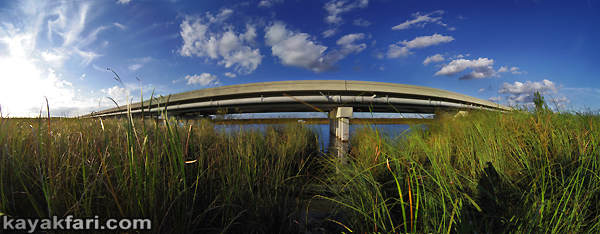
Tamiami Trail – Hwy 41, the dividing line in the Everglades ecosystem!
Paddling under the Everglades Skyway – the one-mile Tamiami Trail bridge over Shark River slough.
.
.
On an invitation from the Reverend Houston Cypress of Love the Everglades Movement, I had the chance to paddle in the interior of Water Conservation Area 3A, near Houston’s ancestral tree island. The Water Conservation Areas are today typically accessed by airboats for practical considerations. Since the 1960s, canoes, kayaks or dugouts have rarely touched these grassy waters. Because dugouts are pretty rare, they are really tough to source. Instead, plastic descendants of another type of native watercraft – the kayak, would be used. This then, is a small attempt at bringing human powered watercraft back to these grassy prairies of water and sky!
.
.
The word ‘kayak’ or ‘qajaq’ comes to us from the native peoples of the high Arctic who developed a type of boat that one wears, rather just being an occupant thereof. It means “hunter’s boat” and was one of the key technological developments that enabled survival in the cold Arctic polar regions. Based on the kayak, an entire culture centered around marine mammals (the main resource available) developed over thousands of years. The word ‘canoe’ comes to us from the Arawak Indians of the Caribbean Islands, but the boat’s origins are far more ancient. The canoe can be considered an open top relative of the kayak, and both of these craft are usually paddled. The native dugout canoes and later ‘cracker’ Glades Skiffs in contrast, were usually poled through the shallow sawgrass marshes.
.
.
On this trip we had a short wide “traditional” sit inside kayak with a classic tapered hull on both ends. The other was a tandem sit on top design with a very shallow vee, flared out hull. She is a lime green Emotion “Comotion”, but I have named her “Pea Pod”. While not a particularly exciting kayak, in the field of tandem sit on tops, not a bad choice really. She moves rather well, tracks well and feels much lighter than other designs. Being only 12 feet long, I usually have the front person use a single bladed canoe paddle to avoid clashing. She is surprisingly versatile and is the one I chose to bicycle trailer-kayak down to Shark Valley to explore tree hammock islands!
.
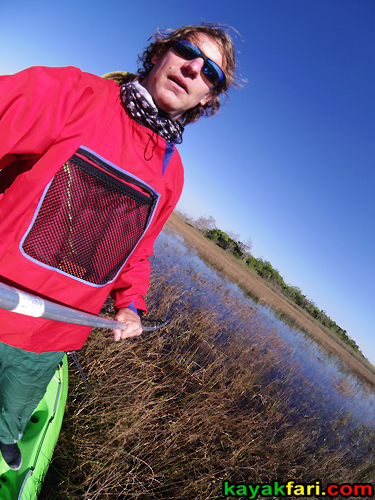
Poling in the Everglades grasses. This was one of the coldest winter days, plus the bright red paddling jacket is easy to see from a distance!
.
You’ll note me wearing a bright red paddling jacket in these pics. I wore it for maximum visibility, because out in the Water Conservation Areas paddle craft are by far the minority. Realistically a red flag on a 10ft pole should be used to alert nearby airboat operators. However as we only paddled around on a known area that was not far from a well established airboat trail, I felt comfortable with just my red jacket and waving paddles if need be.
.
.
With the weight of two people on the tandem sit-on-top kayak, it was difficult to move through the grass. The water was just a little bit too low and the kayak felt too heavy. The hull shape of this lime green tandem kayak isn’t ideal for grass paddling. It’s too wide and tends to want to “grab” the grasses. A nicer, more rounded canoe hull would have worked better, and I believe Houston had an easier time in his single kayak!
.
.
.

Native Seminole dug-out canoes like this one are superior for poling around the ‘Glades.
Circa 1928, floridamemory.com
.
Many cultures around the world have developed and used dugout canoes. This is in fact the oldest type of boat known, dating back at least 8000 years! The Seminole Native dugout canoe adaptations have many advantages over canoes or kayaks in the ‘Glades. They feature a nice bow entry to part the grasses, and a hull design that was narrower than most canoes, yet very stable. At close to 16 feet, they could move quickly and easily poled standing up. In the hands of a skilled operator, they could turn on a dime and the upturned stern would stay clear of debris. I am by no means an authority on dugouts or ancient boats, but as a kayaker all native craft interest me. If you have pertinent information on Seminole dugout canoes, please post a link below!
.
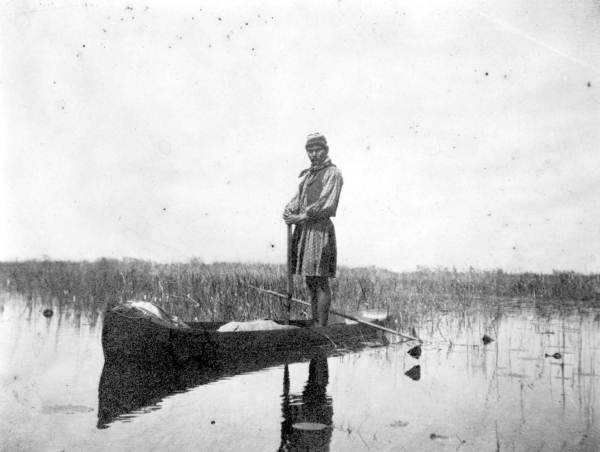
Over a hundred years ago – a Seminole paddler poling along a water lead in the ‘Glades circa 1913.
Source: floridamemory.com
.

Traditional Native boat building survives to this day in Florida!
Artist Pedro Zepeda is a carver of traditional dug-out cypress canoes, pictured here paddling a replica in Ft Lauderdale at the Paddle Up on the Himmarshee event.
.
Ah-tah-thi-ki Seminole Museum
.
In recent times Indigenous peoples the world over have begun to resurrect and rediscover the simple beauty and power of their traditional watercraft. Locally, the Seminole and Miccosukee are no exception. Artists like Pedro Zepeda working with Robin Haines Merrill are bringing it forward to a new audience in the 21st century!
.
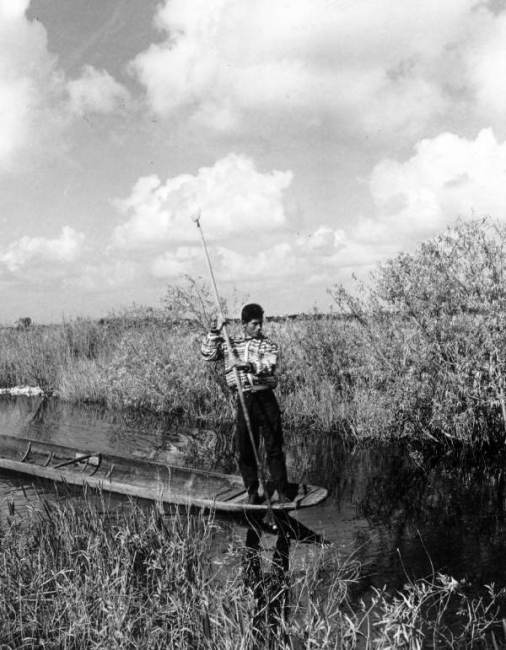
The shape of the versatile Native dugout enables a skilled paddler to move around and utilize leverage for turning and spinning the watercraft around.
Pictured here is Seminole Tommy Tiger in the Everglades, circa 1950. floridamemory.com
.

Famed author, environmentalist and Everglades champion Marjory Stoneman Douglas pictured here in 1983 hitching a ride in a Mikasuki dugout canoe.
.
You can see how dense the grasses grow and how tall the sawgrass easily gets. This is why airboats run red safety flags on top of 10ft poles! However, we were in no danger in this particular section.
.
.

In the middle of the Everglades – “Where the little pot sits” – a hammock island.
CLICK for interactive panorama!
.
.
In the morning I took “Pea Pod” out for a solo cruise around the tree island. It was slow going, but actually a little easier due to less weight to move around. On the flip side, all that vegetation provided really good stability for some low altitude pole aerial photography from the kayak.
I hope you’re enjoying the many
interactive and aerial panoramas of the Everglades!
.
.

Aerial birds’-eye view paddling an old airboat trail around a hammock island.
CLICK for interactive panorama!
.
A BIG thanks to Carmen Ferreiro for these great pics of me in action! 🙂
.
.
.
In the early 20th Century, ‘cracker’ pioneers and settlers developed ‘Glade Skiffs’ patterned after the dugout canoes. These craft enabled living, hunting and fishing for these early Florida families. Their construction varied from very crude to highly refined and lightweight examples made from marine plywood and readily sourced components. Possibly the best known builder of Glades Skiffs was Glen Simmons who grew up in the frontier days of South Florida. His method of using a single sheet of plywood bent up to meet at the bow is an elegant way to make a strong yet lightweight Glades boat. Today this is called “stitch and glue” construction and is very popular for making lightweight hand made wooden kayaks! The shape of the hull is nearly flat for maximum stability and ease of construction and is very similar to some of the SUP boards that are all the rage these days! Obviously this design would need a skeg for use in open (deeper) water, but in the grassy ocean of the Everglades it works well.
.
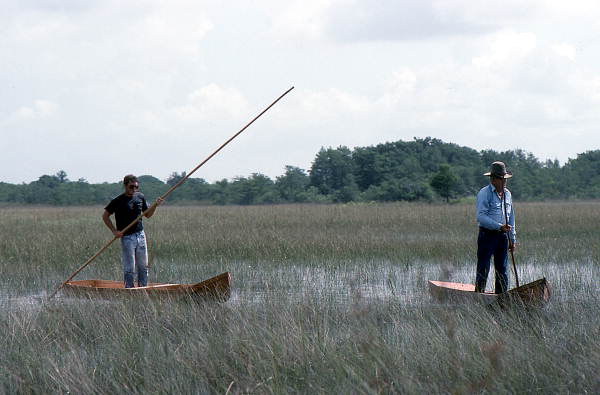
Legendary Gladesman Glen Simmons and two of his Glades Skiffs in the eastern Everglades.
Source: floridamemory.com, 1992.
.
Glen was a true Gladesman and spent much of his time in the Everglades. His biography “Gladesmen: Gator Hunters, Moonshiners, and Skiffers” is a must read for anyone interested in what life was really like back then!
On thing however that Glen Simmons did not have was a camera attached to the top end of the pole! 😉
.
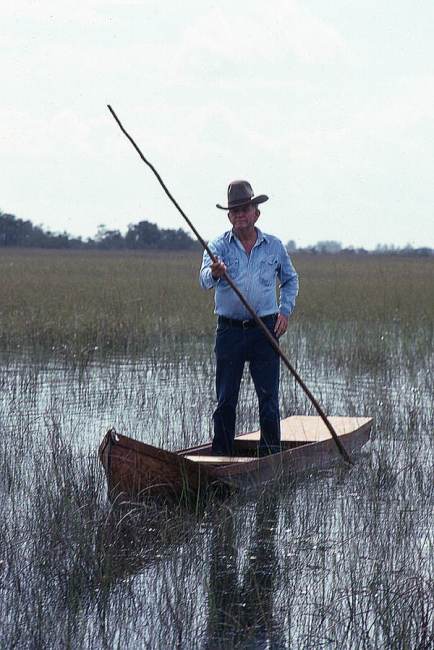
Glen Simmons poling a Glades Skiff in the eastern Everglades. He was an authority on the construction of these unique craft modeled after Native dugout canoes!
Source: floridamemory.com, 1992.
.
The segmentation of the Everglades in the second half of the 20th century effectively ended traditional as well as frontier ways of life and transportation. Airboats have pretty much taken over in the Water Conservation Areas, and it is rare to see paddle craft. This is just a fact of life in as much as motorized transportation has changed everything for everybody around the world. People might complain that airboats are noisy, but it’s the kind of noise that goes away quickly and it doesn’t travel that far. It’s similar to high speed powerboats with outboard motors. Very noisy up close but quickly fading away back to silence. Contrast this with low revving inboard diesel engines which set off a low frequency “chug-chug” that you can hear for miles and miles around!
.

The airboat is the most efficient mode of transportation over the long stretches of the watery ‘Glades!
.
In the permanently flooded Water Conservation Areas of the Glades, the airboat is the best way to get around and reach fishing and hunting grounds and private camps. Still there is something very pure and beautiful being out on the water where it’s just you, the boat and your pole or paddle.
Moving through the landscape at a human pace can be hard work,
but can also be immensely satisfying for body, mind and soul!
.
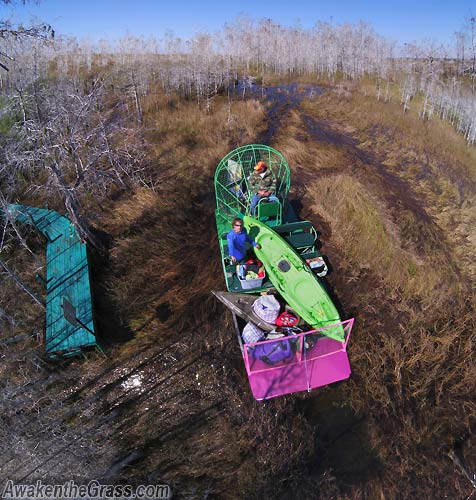
Crow’s eye-view of airboat mothership owned and operated by the “Otter Clan” of the Miccosukee Tribe of Indians of Florida in 2015.
.
The mothership airboat returned us to the Tamiami Trail, where this all started at the Miccosukee Indian Village. Safely back in the 21st century, I drove back to a home in South Florida who’s existence is made possible entirely because of the aforementioned SFWMD canals and levees! I am just one of more than 5 million people who now live on the east coast of South Florida. There is a growing need for quality, affordable and accessible outdoor recreation in all forms. Many South Florida suburban dwellers do not realize that we all live next to the largest roadless wilderness in the “lower 48” States of the Union! We are indeed lucky to have an incredible “back yard” of Biscayne, Big Cypress and the Everglades National Parks as well as the Water Conservation Areas and State Parks!
Public access, along with proper safety education and awareness for all users is a good way to ensure future public support for our unique South Florida ecosystem. This should include additional access and trails for paddle craft like kayaks, canoes, SUPs as well as dugouts and skiffs but also bicycles on the levees and road easements.
Times are changing again for the Everglades, this time for the better. Let’s face it, people care most about the things they know and love. Additional human powered access whether on foot, boat or even bicycle can raise awareness and help drive Everglades Restoration efforts for generations forward!
.
.
“I know that the airboat and the kayak can coexist peacefully!”
.

Riding it out aboard the day-glo airboat kayak mothership of the sawgrass prairies.
CLICK for interactive panorama!
.
Special thanks to Houston Cypress and Love the Everglades Movement for this unique experience!
.
.
Enjoy some
Kayakfari ART Photography!
.
.
.

.
Want even more grass?
.
Paddling under the Everglades Skyway – the one-mile Tamiami Trail bridge over Shark River slough
.
Kayaking at Shark Valley – A visit to Seagrape Hammock, aka Willoughby Key!
.
Crossing paths of Gladesmen, Gator hunters, Outlaws & Moonshiners: An invitation to paddling forgotten trails of the Everglades!
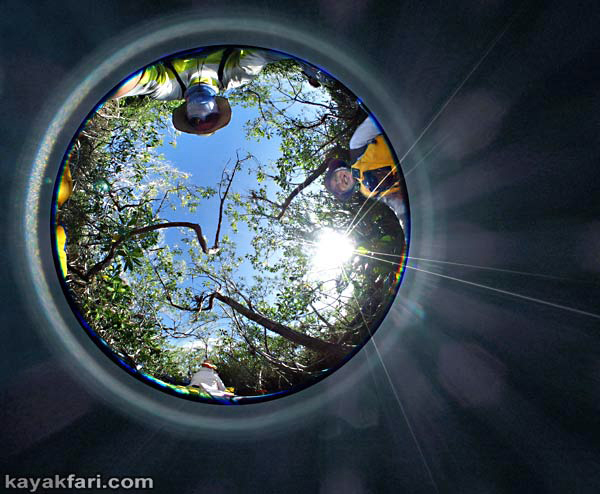
Crossing paths of Gladesmen, Gator hunters, Outlaws & Moonshiners: An invitation to paddling forgotten trails of the Everglades!
.
Pahayokee to Main Street – probing into the Shark River Slough
.
Running down the Taylor Slough!
.
Grass Paddling in the East Everglades Expansion Area – History, Gladesmen & more Grass!
.
Kayaking the River of Grass – a Shark River Slough Expedition.
.
.
.
.
© 2015-2021 Flex Maslan / kayakfari.com / awakenthegrass.com. All original photographs, artworks and music in this portfolio are copyrighted and owned by the artist, Flex Maslan, unless otherwise noted. Any reproduction, modification, publication, transmission, transfer, or exploitation of any of the content, for personal or commercial use, whether in whole or in part, without written permission from the artist is strictly prohibited.
All rights reserved!
…
DISCLAIMER:
The maps and images on this site are not intended for navigation, I am not a guide; use any and all information at your own risk! Your mileage may vary .. so use good judgement before venturing out!
…
I hereby disclaim any sponsorship, endorsement, nor association with any product or service described herein. The photographs, depictions, products, and ideas presented on this site are for informational purposes only. Your results may vary, and I do not imply nor guarantee the effectiveness, suitability, design or operation to adhere to any standard. I assume no legal responsibility for the implementation of anything herein presented! Use any and all information at your own risk! By using any and all information from this website, you accept the final liability for any use or possible associated misuse!
.
With that said..
Blessings friends!
🙂


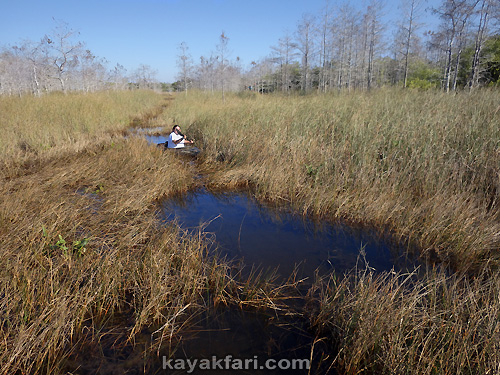
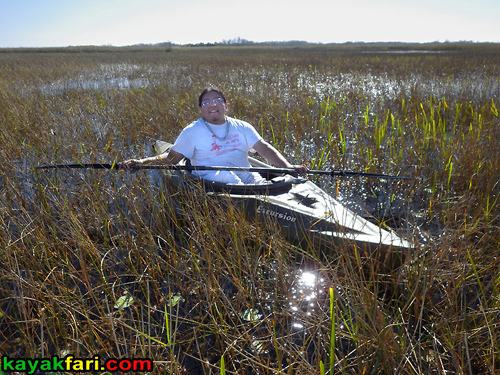


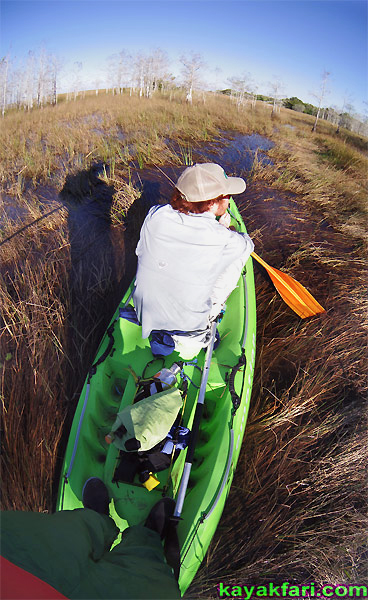
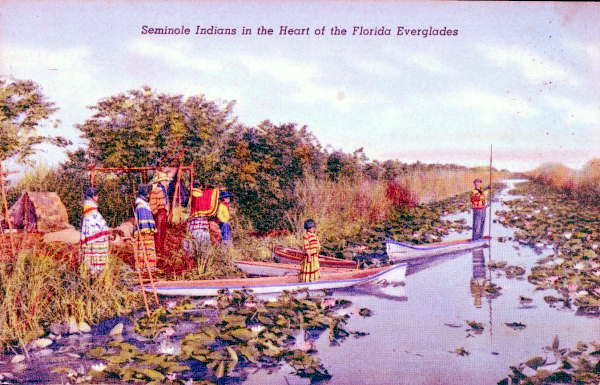
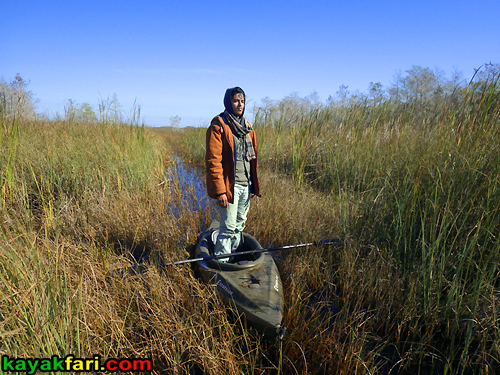

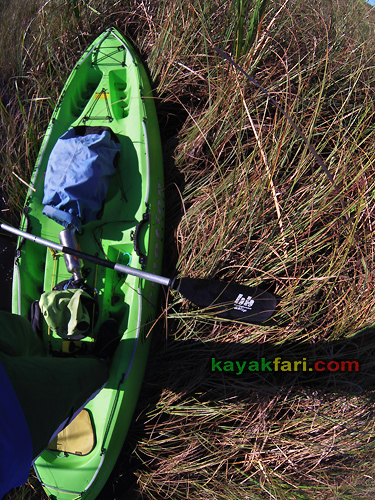
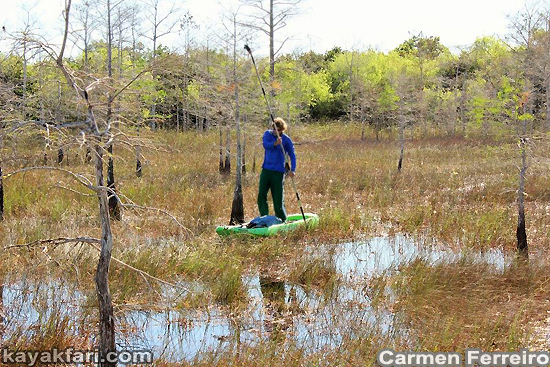

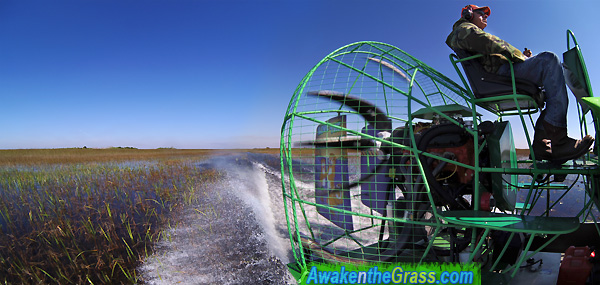
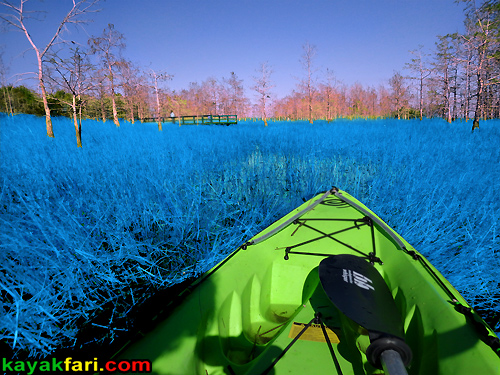




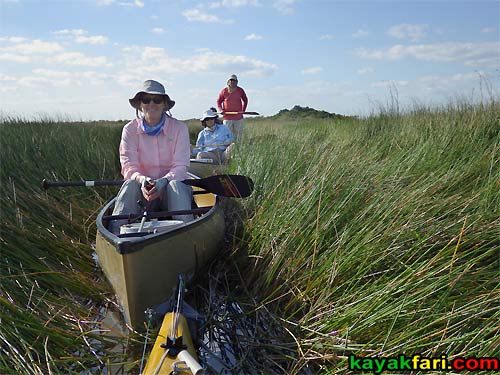
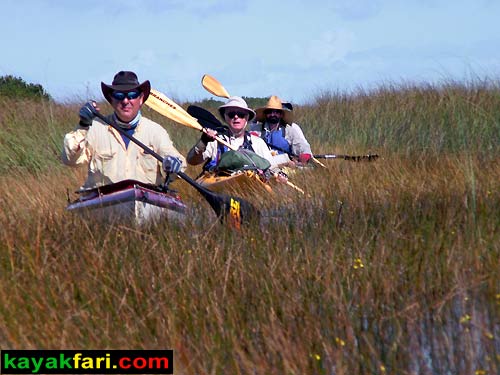
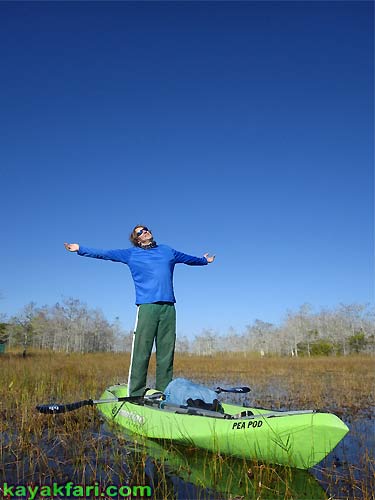
Pingback: Poling and Paddling: Everglades Conservation Areas – the case for Grass Paddling! | kayakfari ( kayak .. far .. i )
Great post
LikeLike
Thanks Enrique!
LikeLike
Very interesting and educational article, it makes me want to get a boat and get out there.
LikeLike
Right ON!
LikeLike
Pingback: Paddling and exploring South Florida’s wilderness – the sloughs of the Everglades! | kayakfari ( kayak .. far .. i )
Pingback: Flooded Shark Valley high water paddling in the Everglades on the “Pa-Hay-Okee”. | kayakfari ( kayak .. far .. i )
Pingback: The Daily Dose – Modes of travel in the Everglades: Yesterday, today and tomorrow! | kayakfari ( kayak .. far .. i )
As always love the story.
LikeLiked by 1 person